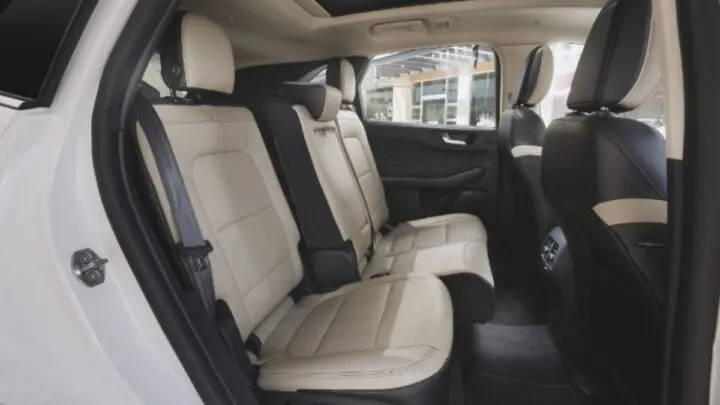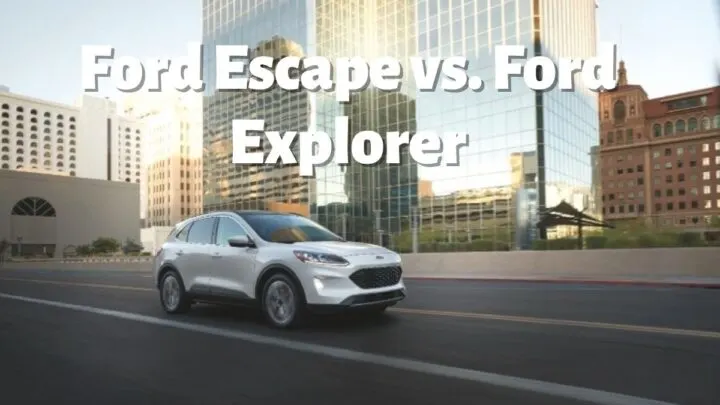The Escape and the Explorer are popular among SUV enthusiasts around the globe, especially in North America.
Both cars offer great reliability, dependability, and comfortability across their myriad drivetrain and powertrain options.
The main differences between the Ford Escape and the Ford Explorer are that the Explorer offers great fuel mileage and a smaller overall carriage, while the Escape is generally more expensive, but offers many more amenities and are more well-balanced.
Which one suits you? And, which is the better overall SUV?
Read on to find out!
Engine Specs and Performance
An SUV’s drivetrain and powertrain components are among the many factors that enthusiasts look for in any car before settling on a purchase.
And more so when it comes to cars from the same manufacturer.
The Ford Escape and Explorer SUVs fall into different SUV classes, with the Explorer being a 3-row midsize SUV while the Escape is a 2-row compact crossover SUV.
Here, look at the various engine specs across the trims and how they affect the vehicles’ handling and performance.

Ford Escape
The Ford Escape is an excellent small family car with two gas engines and two hybrid powertrain choices.
The first option available is the rather underpowered 1.5 -liter EcoBoost I3 engine that produces 181 horsepower coupled with 190 lb-ft of torque and a front- or all-wheel drive.
The car’s engine may seem somewhat underpowered, but will serve you well if you mainly drive in the city.
The second option is a stronger 2.0-liter EcoBoost I4 with 250 horsepower, 280 lb-ft of torque, and an all-wheel-drive (AWD) drive.
The engine is better than the 1.5-liter EcoBoost, with more gust of power that ensures your car doesn’t strain a lot at highway speeds.
Additionally, the engine has better acceleration and scores a 5.7-second split from 0 to 60 mph. In comparison, the 1.5-liter engine achieves the same benchmark in a sluggish 7.7 seconds.
The third option is a 2.5-liter iVCT Atkinson-Cycle Hybrid engine that produces 200 combined horsepower and 155 lb-ft of torque.
It comes with a front-wheel- or all-wheel-drive drivetrain. The powertrain features a 96 KW motor and an electronically controlled continuously variable transmission (eCVT).
The final engine option is the Plug-in Hybrid 2.5-liter iVCT Atkinson-Cycle I-4 engine with 221 combined horsepower, 155 lb-ft of torque, and a front-wheel drivetrain.
It’s worth noting that all the engines come with an eight-speed automatic transmission, which is not-so-impressive, as it shifts slowly and seems unrefined.

Ford Explorer
The Ford Explorer is a big midsize SUV with excellent engines, powerful drivetrains, and rear-wheel-drive platforms for better towing.
The car is well-crafted with good interiors, excellent handling, and great versatility. Moreover, the Explorer can handle its powerful engines well, ensuring a smooth ride to your destination.
The base models feature a 2.3-liter EcoBoost Turbo I4 engine, a rear-wheel or 4-wheel drive, and a 10-speed automatic transmission.
The four-cylinder gasoline engine produces 300 horsepower and 210 lb-ft of torque.
Additionally, for the off-roaders, you’ll get standard features such as Terrain Management System and the Trailer Sway Control.
And if you still need more control over your vehicle, you can add a pair of optional Hill Descent Control and intelligent 4WD.
And if you need more power, go with the ST, King Ranch, or Platinum models.
The three power models feature a 3.0-liter EcoBoost V6 engine capable of producing 400 horsepower and 415 lb-ft of torque, paired with a rear-wheel-drive or 4WD drivetrain.
Additionally, you can opt for the 3.3-liter Hybrid V6 engine that pairs with an electric motor to produce a combined 318 horsepower and 322 lb-ft of torque. For the hybrid model, you can opt for a rear-wheel drive or a 4WD trim.
Fuel Economy and MPG Ratings
SUVs are generally bigger, heavier, and have stronger engines than sedans. In other words, fuel consumption isn’t their stronghold.
And as the Escape is lighter than the Explorer, expect it to have better fuel economy figures. But how efficient is it?
Here’s a look at their fuel consumption figures.
Ford Escape
The Ford Escape has slightly varying fuel economy figures owing to its many drivetrain and powertrain options.
According to the EPA, the turbocharged 1.5-liter EcoBoost I3 model with front-wheel-drive has the best fuel economy among the gasoline-powered models.
It’s rated for 27 MPG city, 30 MPG highway, and 33 MPG combined.
Here’s a look at its EPA-estimated fuel ratings.
- 1.5L 3-cylinder automatic 8-speed engine with FWD: 27 MPG city/ 34 MPG highway/ 30 MPG combined.
- 1.5L 3-cylinder automatic 8-speed engine with AWD: 26 MPG city/ 31 MPG highway/ 28 MPG combined.
- 2.0L 4-cylinder automatic 8-speed engine with AWD: 22 MPG city/ 31 MPG highway/ 26 MPG combined.
- 2.5L 4-cylinder automatic HEV engine with FWD: 44 MPG city/ 37 MPG highway/ 41 MPG combined.
- 2.5L 4-cylinder automatic HEV engine with AWD: 43 MPG city/ 37 MPG highway/ 40 MPG combined.

Ford Explorer
The rear-wheel-drive model is Explorer’s most fuel-efficient car, with estimates of 27 MPG city, 29 MPG highway, and a combined 27 MPG.
Here’s a look at its EPA-estimated fuel ratings.
- 3.3L 6-cylinder Hybrid engine with RWD: 27 MPG city/28 MPG highway/ 27 MPG combined.
- 2.3L 4-cylinder engine with RWD: 21 MPG city/28 MPG highway/ 24 MPG combined.
- 3.0L 6-cylinder engine with RWD: 18 MPG city/26 MPG highway/ 21 MPG combined.
Manufacturer’s Suggested Retail Price
Ford Escape
The Escape is smaller and less powerful than the Explorer, commanding a smaller base price.
But generally, the model suffers when compared to other compact crossover SUVs from competitor companies.
Price-wise, you’ll have to pay more to get features such as dual-zone climate control, which are standard in other cheaper models.
Here’s a look at the Escape models’ MSRPs.
- S – $27,025
- SE – $28,360
- SE Hybrid – $30,185
- SE Plug-in Hybrid – $35,455
- SEL – $30,735
- SEL Hybrid – $32,550
- SEL Plug-in Hybrid – $38,190
- Titanium – $37,145
- Titanium Hybrid – $35,095
- Titanium Plug-in Hybrid – $40,700
Ford Explorer
Ford Explorer has a ton of features spread across its ten trims. You’re sure to get all you need in this midsize SUV.
Here’s a look at the Explorer MSRPs.
- Base – $34,010
- XLT – $38,320
- ST-Line – $45,510
- Limited – $46,820
- Timberline – $48,800
- ST – $49,740
- Limited Hybrid – $51,000
- Platinum – $52,125
- King Ranch – $54,610
- Platinum Hybrid – $55,000
Interior Design and Cargo Space
An SUV is a powerful vehicle that can be less forgiving if its interiors don’t match up to standard.
On the brighter side, Ford has decent interiors across the two SUVs.

Ford Escape
The Ford Escape has decent but not premium interiors, featuring simulated leather interiors, soft-touch plastics, an 8-inch infotainment screen, and plenty of leg and headroom.
The car also features 33.5 cubic feet of designed cargo space, so the cargo won’t cut into its rear visibility.
Furthermore, the SUV has an easy-to-use voice-activated SYNC 3 technology, six cup holders, a central floor console with armrest, power windows, an outside temperature display, and a ton of driver-assist and safety features.
Also, the Escape’s seat arrangement is well-engineered, with enough leg and headroom on both front and back rows,
Ford Explorer
The Ford Explorer cabin is comfortable and functional, but nothing extraordinary.
The first two rows are spacious and comfortable, but the challenge comes with the third row.
It’s relatively squeezed with bare minimum legroom that can sit kids and young adults. Getting to the third row is easy, as you only need to press a button.
Additionally, the trims have different comfort and luxury features.
The King Ranch trim has 8-way power passenger seats, PowerFold third-row, rear-seat entertainment systems, 8.0-inch infotainment screens, and voice-activated navigation.
It also has 152.7 cubic-feet passenger volume and 87.8 cubic-feet cargo volume.
Final Remarks on the Ford Explorer vs. Ford Escape
Three key differences between the two SUVs are their cargo volumes, price tags, and fuel economy ratings.
Whereas the Escape has exemplary MPG ratings, it suffers massively due to its smaller size.
The five-passenger escape has 104 cubic feet of passenger volume, compared to the Explorer’s 152.7 cubic feet.
In conclusion, fuel economy and volume are the two distinct features of the two Ford models.
Other than that, the higher Explorer price tags are justifiable as they’re bigger, stronger, and well-balanced than the Escape.
